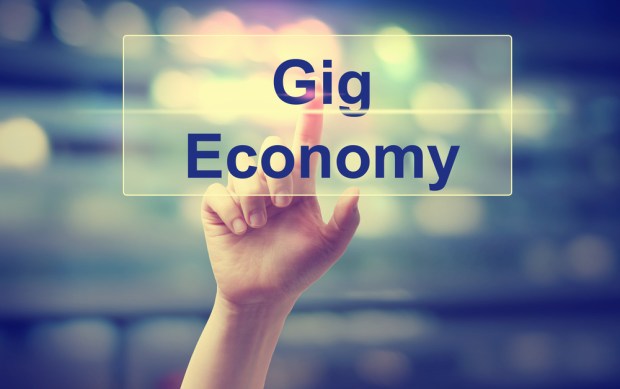Grabbing Hold Of The Gig Economy’s Long Tail

Beyond Uber and Lyft, the gig economy is evolving, with a long tail that places value on plugging gaps in firms’ skill sets and boosting gig workers’ discretionary spend, too. Hyperwallet SVP Michael Ting tells Karen Webster in the latest Data Drivers that the value of the online marketplace lies in matching services and the firms that need them — and making sure payment is seamless.
The gig economy is gaining traction, evolving and expanding globally … and maturing.
It’s no longer just bringing sellers (those would be the freelancers) and buyers (the employers or projects) together in a friction-filled experience, where freelancers are busy shopping themselves and their skills to would-be takers. The activity is more evenly matched, with payments thrown into the mix.
In an interview with Michael Ting, SVP of digital markets at Hyperwallet, the details were in the Gig Economy Index on just how the times are a-changing.
Data Point Number One: 35 Percent
To get a sense of just how pervasive gig work is, consider the fact that the 35 percent mentioned above is the percentage of the adult population within the U.S. that is part of the gig economy.
And more than half of that tally also has a full-time job. That’s an outgrowth of an accelerating trend where people are discovering new opportunities beyond the standard full-time gig, said Ting.
The allure is there, marked by the relative ease in finding project-based work, made simpler with the aid of technology and online marketplaces. The full-time employee, said Ting, can earn money or perform jobs without it having to be a commitment.
Thus, said Webster, the gig economy has a long tail.
This is no longer the world of Uber and Lyft. Specialization is fast becoming among the defining characteristics of the gig economy. Some 41 percent of workers say they were hired because they have skillsets that stretch beyond the ones valued by their traditional places of employment. Said Ting, the long tail is also one where value lies in firms being able to deliver tasks to gig workers without having to onboard them.
“I think both of those dynamics are kind of pushing against each other, and are starting to create a bigger opportunity for the skilled workers,” said Ting.
One side benefit, one that keeps freelancers, well, freelancing: discretionary income.
Said Ting, “when people see any opportunity to be able to bank extra money, they’re going to take advantage of that – particularly if they need not necessarily have to go out and search for those opportunities.”
Data Point Two: 59.1 Percent
This is the percentage of gig workers who say they find work using an online marketplace.
A single marketplace, done well, specialized perhaps, is one that eliminates friction. And as Ting noted, the concept has been around for a long time, with a precedent in eCommerce. The template is there, with supply and demand, with online ratings systems, among other attributes. It may come as no surprise, then, that 55 percent of gig workers use only a single marketplace.
But critical mass is … critical.
“It’s a very delicate balance and it’s very difficult,” mused Ting of the drive to attract skilled talent that employers will use on a recurring basis. “It’s one of the biggest challenges the marketplaces face. How do you retain the best people on your platform … and how do you create a new user experience … where new people coming in do not feel like they are getting buried at the bottom of the pile?”
Data Point Three: 40 Percent
That’s a sizable sum grabbing at paper checks. Why so sticky, these dead trees?
Simply put, said Ting, the marketplaces are still stuck in version 1.0.
“They are still focused on playing the role of a matchmaker and trying to match supply and demand and optimize algorithms,” he said, so payments tend to wait until critical mass is achieved.
Yet, as Webster noted, 84 percent of gig workers surveyed said that it they got paid faster, they would actually want to do more work, so it all becomes a self-sustaining ecosystem.
“The marketplaces are still dependent on payment providers and banks,” noted Ting. “The delivery of the last mile oftentimes is out of their control” where payments are concerned. Prepaid cards are mired in physical processes tied to applications, delivery of the cards and activation.
Ting reflected on the movement to faster payments. “We are seeing early signs of bank deposits, like typical bank transfers. We’re starting to see a lot of the local payment networks experiment with faster payments and same-day payments … being able to receive your money in the traditional way into your bank account, I think we’re only going to see more movement toward that,” he told Webster.
“The caveat is that the global marketplace has the challenge of having to open up bank accounts around the world … and manage balances in different currencies,” he added.
Also, noted Ting, eWallets are gaining ground, with holders treating them like bank accounts.
He stated that there has been a move to provide users with earlier payments to use as cash flow or working capital.
Against that backdrop, the risk underwriting becomes important. As Ting noted, delivery of goods is easy to validate, but delivery of digital services is harder to confirm.
“It’s one thing to do a verification upfront,” he said, while marketplaces can rely on “some sort of self-reporting of what their services are providing and the quality of it. But it’s another thing to do an ongoing audit and make sure that [parties] are staying true to their word.”
